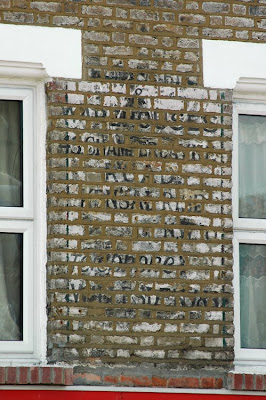What are the chances of seeing in Cuba an advert for Coca Cola, a product that in many ways has come to symbolise US imperialism? Pretty slim I would have thought since there is no advertising on the island (but plenty of political propaganda) and Coca Cola ceased trading with Cuba following the nationalisation of its properties there in 1961 (*). Still, there I was, walking back towards the centre of Santa Clara from the monument and mausoleum where the remains of Ernesto 'Che' Guevara and his companions who died in Bolivia are buried (the socialist-style monument has some interesting sculptures and the museum is about the man himself rather the revolutionary hero, so regardless of what one thinks about Che, it's worth a visit), when I spotted this surprising ghost sign. Actually it is located almost opposite the
Firestone tiles I posted earlier.

Tómese
Coca Cola
Bien fría 5c | | [Drink
Coca Cola
Ice-cold 5c] |
Coca Cola first appreared in Cuba as a fountain drink in the very late 1890s or 1900, in the aftermath of the 1898 Spanish-American War. The presence of US troops (most withdrew when Cuba gained formal
independence in 1902 though) and above all the development of tourism boosted sales of Coke. In 1906 Coca Cola opened its first bottling plant in Havana. Sustained advertising campaigns in Spanish followed and sales shot up during the first half of the century. Soon after Coca Cola built one of its largest plants outside the US in Santa Clara, a centrally-located industrial centre 270 km east of Havana. Cuba was not only a huge market for Coca Cola's products but also the source of most of the sugar needed to produce the drinks.
However the victory of Fidel Castro and his
barbudos, and the advent of the revolutionary regime was to change all this. For a few months US companies continued operating as usual but the relation between Cuba and the US soured after the government implemented its first agrarian reform in March 1959 (around three quarters of the arable land was owned by foreigners, mostly US companies). A few months later, when US-owned refineries in Cuba refused to process cheaper Soviet oil, in spite of what was stipulated in their contract, Castro nationalised them. The Eishenhower administration retaliated by suspending the Cuban sugar quota in the US. The immediate answer from Havana was the nationalisation of all remaining US properties in 1961, including Coca Cola. At the time the company had assets estimated at US$ 27.5 million in Cuba.
One of the last Coca Cola advertising campaigns in Cuba ran in early 1961. In January that year the government launched a year-long campaign to eradicate illiteracy and mobilised vast resources to achieve its goal. Coca Cola 'participated' by running a printed ad which showed a well-off white lady, with a bottle of Coke nearby, guiding the rough hand of her darker employee to teach her how to write. The message was "In 1961, the Year of Education, use your 'pause that refreshes' to teach reading and writing to whomever you have near." "Every little helps" (so says a famous British ad) but the 145,000 youth, students, teachers, and workers who volunteered to teach in rural communities and factories across the island certainly made more of a difference than the Coca Cola lady.
(*): True, it has been possible for some years to drink a Coke in Cuba but it is bottled by the Mexican subsidiary of the Atlanta-based giant (Coca Cola argues it doesn't authorise any bottler to sell or distribute its drinks in Cuba but it can't prevent them from doing so when they are located in countries where Cuban import-export companies can operate freely, as it is the case in Mexico. Obviously that's a convenient way of doing business without breaching the US embargo, although Coke would be classified as 'food' and as such would not be submitted to it). Coca Cola can be bought in Convertible pesos (CUC) at a cost roughly of one CUC (just under 1 euro). Tu Kola, the locally-made version of Coke, only costs a fraction of that in peso
moneda nacional. Is there a difference between the two? I couldn't say. The smell of either of them is enough to make me sick.
Location: Calle Marta Abreu, Santa Clara / Picture taken on: 02/04/2010




































%20Costaros%20N88.JPG)







